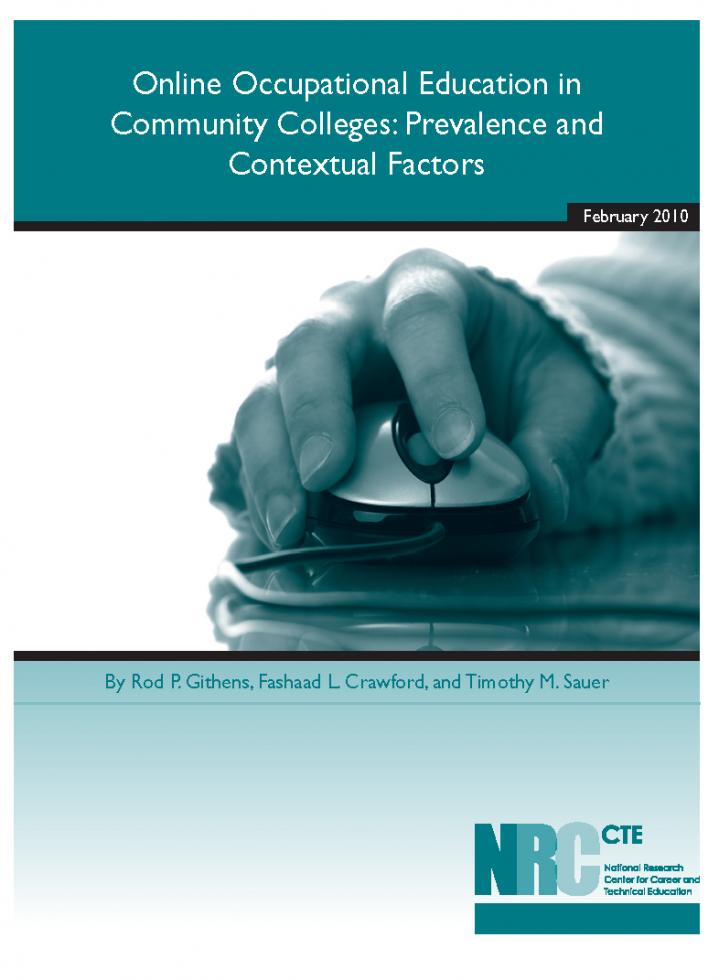Online Occupational Education in Community Colleges
 This study examined the current
state of online occupational programs in community colleges and
explored issues related to institutional, economic, and social
indicators that influence (a) the offering of online programs and
(b) the programmatic connection to workforce development needs.
This project is the first national study that categorizes and
inventories specific types of online occupational programs in
community colleges. The study included a national random sample
of 321 institutions in the United States. Data were collected
through institutional websites, statewide websites, follow-up
emails, and phone inquiries to institutions. The following
sections summarize key findings.
This study examined the current
state of online occupational programs in community colleges and
explored issues related to institutional, economic, and social
indicators that influence (a) the offering of online programs and
(b) the programmatic connection to workforce development needs.
This project is the first national study that categorizes and
inventories specific types of online occupational programs in
community colleges. The study included a national random sample
of 321 institutions in the United States. Data were collected
through institutional websites, statewide websites, follow-up
emails, and phone inquiries to institutions. The following
sections summarize key findings.
Prevalence of Programs
- Among sampled institutions with data available (n = 301), 47.5% offered credit-granting online occupational programs. We defined online occupational programs as limited to programs that the institutions identified as being online, with 50% or more of course content available through online communication technologies.
- Although 47.5% of institutions offer online occupational programs, previous NRCCTE research found that 76.3% of institutions offer credit-granting occupational courses (Johnson et al., 2003). This finding suggests a need for institutions to build and promote online programs in order to create increased accessibility for students searching for cohesive sequences of online courses.
- Most online occupational programs were in subjects that are more easily taught online. In the sample, 43.6% of all online occupational programs were part of the Business Management/Administration and Marketing fields. Although programs were available in skill-based fields like Health Science, most such programs were in areas such as Health Informatics, which are more easily taught online.
- Previous NRCCTE research found that courses in skill-based fields like Veterinary Technology and Funeral Service Education can be successfully taught online when integrated with face-to-face, lab, or clinical requirements (Benson et al., 2004). The current study found that such programs are rare, which illustrates a need for institutions and states to provide the resources necessary to develop such programs, especially in high-need Health Science, Green Technologies, and skilled Manufacturing occupations.
- A small majority of the online occupational programs in the sample award certificates or diplomas (52.4%) rather than associate’s degrees (47%). Other studies have found that community college certificate programs have declined in popularity since 1990 (Levesque et al., 2008). However, online certificate programs provide convenient and accessible options that lead to greater results for some students. According to evidence from Florida, occupational certificate programs can provide students from weaker economic and academic backgrounds with the most opportunity for economic mobility compared to other degree options (Jacobson & Mokher, 2009). This finding illustrates that institutions are providing some valuable online options for students from less advantaged academic and economic backgrounds.
Connection to Workforce Development Needs
- Among colleges offering online occupational programs, 26% offered one or more programs associated with the state’s five fastest-growing occupations (overall average of .65 programs per college in the five fastest-growing occupations).
- Among the institutions offering online occupational programs, 39% offered one or more programs in the state’s top 10 occupations with the most projected openings (overall average of .89 online programs at each college in the sample).
- A minimal relationship existed between colleges’ online offerings in high-demand, high-growth fields and the specific institutional, social, and economic characteristics for institutions. In other words, little meaningful connection was found to indicate that certain types of institutions (e.g., in counties with high unemployment) were more likely to offer online occupational programs in high-demand, high-growth fields in their states. The only meaningful finding was a minimal connection with the degree of statewide centralization for the institutions.
Community and Institutional Demographics
- Institutions with higher percentages of White students are more likely to offer online occupational programs. However, other national studies have found that students of color and White students have comparable participation rates in distance education (Flowers, Moore, & Flowers, 2008; National Center for Education Statistics, 2003b). These findings illustrate a potential need for additional online program development in colleges with larger percentages of students of color.
- Most institutional, social, and economic indicators had no role in determining whether colleges offered online occupational programs. Aside from racial variables, variables such as institutional enrollment, percentage of part-time students, and local unemployment rates had no relationship with whether institutions offered online occupational programs.
Governance and Centralization
- Institutions operating under statewide governance structures and in states with more highly centralized statewide practices have more online occupational programs than other types of institutions.
As online education will play an increasingly central role in the nation’s workforce development efforts, this study will provide institutions and policymakers with national data to influence future decisions.
Githens, R. P., Crawford, F. L., & Sauer, T. M. (2010, February). Online occupational education programs in community colleges: Prevalence and contextual factors. Louisville, KY: National Research Center for Career and Technical Education, University of Louisville.

